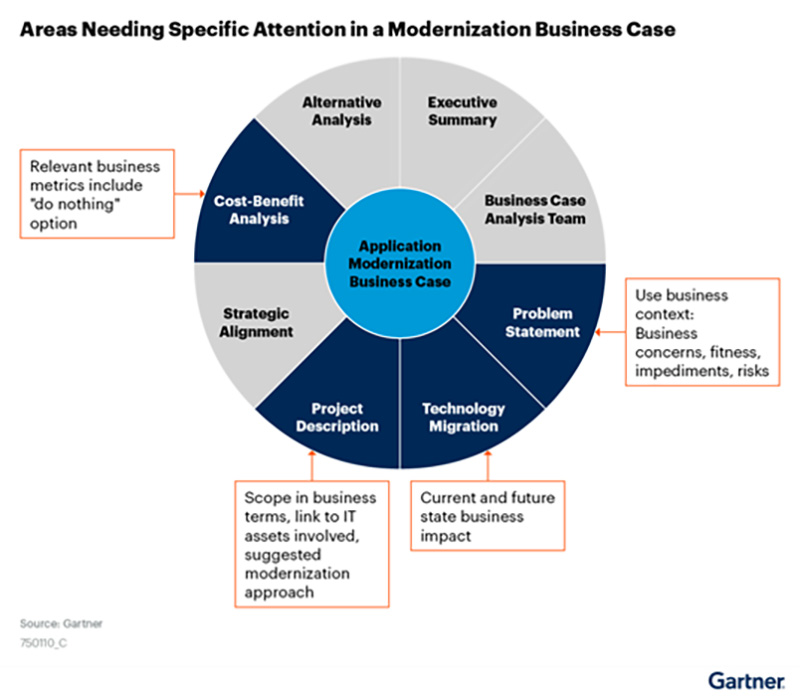
Prioritize and Build a Strong Business Case for Modernization to Accelerate Your Digital Transformation
Modernization is a key facet of digital transformation as it involves adopting and integrating new technologies, processes, and strategies to improve efficiency, productivity, and competitiveness. Digital transformation often involves the use of digital technologies to automate and streamline business processes, improve customer experiences, and enable new forms of innovation and value creation. Modernization is necessary to keep up with the rapid pace of technological change and to take advantage of the opportunities that digital technologies offer.
For example, modernizing business processes through the use of digital technologies can help organizations reduce the time and resources required to complete tasks, improve the accuracy and reliability of information, and enhance communication and collaboration. Modernization can also help organizations to better understand and respond to the needs and preferences of their customers, as well as stay ahead of the competition by adopting new technologies and approaches.
Overall, modernization is a crucial aspect of digital transformation because it enables organizations to continually evolve and improve to stay relevant and competitive in a rapidly changing digital environment.
Yet, despite the strong correlation between modernization and successful digital transformation, CIOs and IT leaders often find it challenging to create a modernization business case that convinces management — especially business stakeholders — to invest, with case weakness often stemming from taking an IT-centric approach.
To build a strong business case for modernization, Gartner recommends that you:
- Align your application modernization business case to business objectives, priorities, and appetite for change by using four critical business case sections: problem statement, technology migration, project description, and cost-benefit analysis.
- Prioritize critical business capabilities and identify associated applications for modernization by executing a business-led analysis of IT assets.
- Reduce disruption, risk, uncertainty, and time to value by dividing the application modernization program into multiple smaller waves of work. Use business capability value to identify, prioritize, and bundle applications into these waves.
 Source: Gartner - Building a Successful Business Case for an Application Modernization Program
Source: Gartner - Building a Successful Business Case for an Application Modernization Program
There are several risks that organizations should consider when modernizing their business processes and systems through digital transformation. Some of the potential risks of modernization include:
- Cost and budget: Modernization can be a costly undertaking, particularly if it involves the implementation of new technologies or the overhaul of existing systems. Organizations need to carefully consider the costs and benefits of modernization in order to ensure that it is a viable and worthwhile investment.
- Complexity: Modernization can also introduce new levels of complexity, particularly if it involves integrating multiple systems or adopting new technologies. This can make it challenging to manage and maintain the modernized systems and may require hiring additional staff or implementing new processes to ensure smooth operation.
- Disruption to operations: Modernization can also disrupt business operations, especially if it involves significant changes to systems or processes. It is important to carefully plan and manage the modernization process in order to minimize disruption and ensure that operations can continue as smoothly as possible.
- Security and privacy: Adopting new technologies and systems can also introduce new security and privacy risks. Organizations must carefully consider and address these risks to protect their data and assets and maintain the trust of customers and stakeholders.
- Resistance to change: Finally, modernization can be met with resistance from employees and other stakeholders who may be hesitant to adopt new technologies or change longstanding business processes. It is important to effectively communicate the benefits and rationale for modernization and to provide training and support to help employees adapt to the changes.
At Intelliswift, we have a multi-discipline team focused on helping customers with their modernization journey. On one hand, we have a strong product engineering team leveraging the latest programming tools and frameworks, with associated DevOps and Test Automation teams to help customers migrate their legacy applications to a contemporary, microservices/API-based, cloud-native underpinning. On the other hand, we have folks reimagining how these apps will be hosted and delivered in a multi-cloud or hybrid-cloud world. Our recent conversations with our customers' IT leadership suggest that modernization is going to be a key component of IT spend portfolio in 2023. We look forward to being a part of our customers' modernization journey in 2023 - our skilled professionals, along with our best practices, frameworks, accelerators, agile execution, and choice of partner technologies and tools enable us to reduce time to market, while mitigating the risks frequently associated with modernization.
Get in touch with us for a quick assessment of your app modernization requirements.

Sanjay Kalra, Digital Transformation Sherpa
Sanjay is a highly experienced subject matter expert in Information Technology, Product Engineering, Customer Experience, Cloud, Automation, Data Analytics, and AI – which enables him to serve as a trusted advisor to enterprises and growing organizations.

